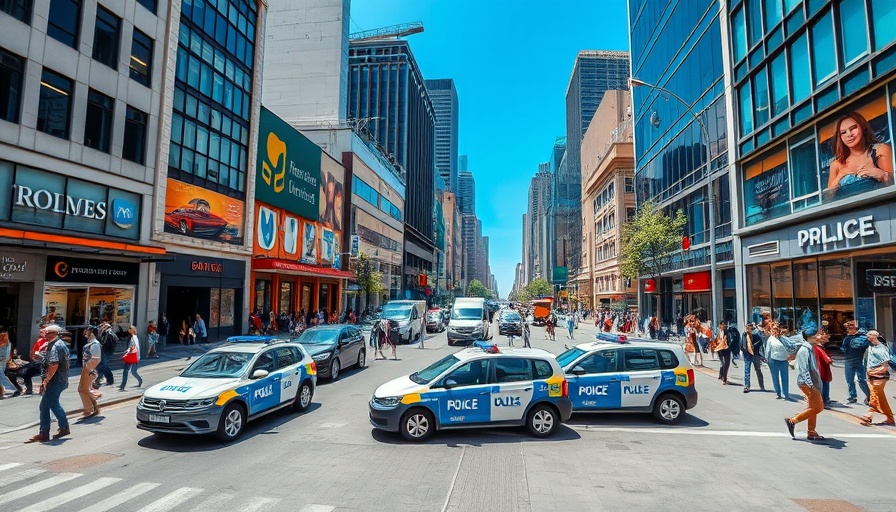
The 16th Street Plaza Crackdown: What’s Happening at 15th and Mission?
Day 78 marks a notable shift at the busy intersection of 15th and Mission Streets in San Francisco, as local shopkeepers are beginning to share their experiences amidst the ongoing crackdown at the 16th Street Plaza. The SFPD's mobile command unit, stationed strategically since the crackdown commenced, aims to address rising concerns about safety and cleanliness in the area.
Shopkeepers Speak Out: A Safety Boost or Just a Facade?
Victoria Ochoa, a deli worker at La Noisette, describes how the plaza's atmosphere has evolved over the past few weeks. "On weekdays, there are more homeless individuals present, and on weekends, vendors seem to scatter when they sense police presence," she shares, emphasizing the noticeable increase in garbage littering the streets. This juxtaposition highlights the sharp contrast in livability for both patrons and local businesses.
Across the street, Sam Ao, from Puff and Stuff tobacco shop, echoes Ochoa's sentiments, remarking on the positive impact of the mobile command unit. Many shopkeepers express that its constant presence fosters a sense of security. However, others, like Mo K from a nearby clothing store, question its real utility. “It’s good to have it,” Mo mentioned, “but what could it possibly do?” This raises a broader conversation about policing efficacy and community trust.
Community Voices: Safety Versus Surveillance
The mixed feelings about the mobile unit encapsulate a larger dialogue within the community regarding public safety in urban environments. While some commend the police presence for reducing incidents of open drug use and violence, others remain skeptical. Mo continues, reflecting on the psychological versus tangible effects of the command unit, and its limitations in addressing the root causes of the challenges faced. “It’s more about peace of mind than actual safety. The deep issues will still remain,” he states.
This leads to an insightful parallel: how can community initiatives be effectively combined with police action to foster a safer environment? Local leaders and city council members may need to explore innovative approaches that go beyond mere enforcement.
Impact on Local Businesses: Reflections and Future Prospects
As shopkeepers navigate this evolving landscape, the effects of the crackdown on local businesses become increasingly apparent. Increased foot traffic, albeit tempered by the policing efforts, has resulted in varied reports among merchants. While many welcome a slight decrease in visible crime, Ochoa notes that, despite the improvements, significant barriers remain, including persistent issues of debris and public disorder. These factors directly influence both customer experiences and business performance.
Reflecting on these developments, small business owners are starting to advocate for greater community initiatives that extend beyond law enforcement. Talks of local clean-ups, neighborhood watches, and partnerships with nonprofits could bolster efforts to create a more cohesive environment. Building stakeholder connections could engender transformation, altering the community narrative from one defined by safety concerns to one rooted in proactive engagement.
Future Predictions: What Lies Ahead for 16th Street?
Looking forward, stakeholders must contemplate the long-term strategies needed for sustainable safety in the Mission District. A collaborative framework that integrates public safety strategies with local community initiatives may hold the key to meaningful progress. Current reports indicate a fraction of improvement in safety but still reveal an array of issues that require dedication to resolve, such as homelessness and socio-economic challenges.
Community involvement is crucial. As residents express their perspectives, city leaders can devise plans that truly resonate with those most affected. Similarly, ongoing dialogues that emphasize diverse voices will foster broader support for initiatives. Small-scale programs that encourage social connection may bridge gaps between residents and the police, thus enriching the neighborhood fabric.
Conclusion: A Call for Collective Action
Ultimately, the events unfolding at 15th and Mission are about more than policing; they represent a community grappling with complex issues at a pivotal moment. Engaging in open conversations, fostering community involvement, and bridging divides may initiate the change needed for a more harmonious environment. Parents, residents, and local business members are encouraged to take part in community meetings and engage with local governance processes to advocate for their neighborhoods.
 Add Row
Add Row  Add
Add 




 Add Row
Add Row  Add
Add 

Write A Comment